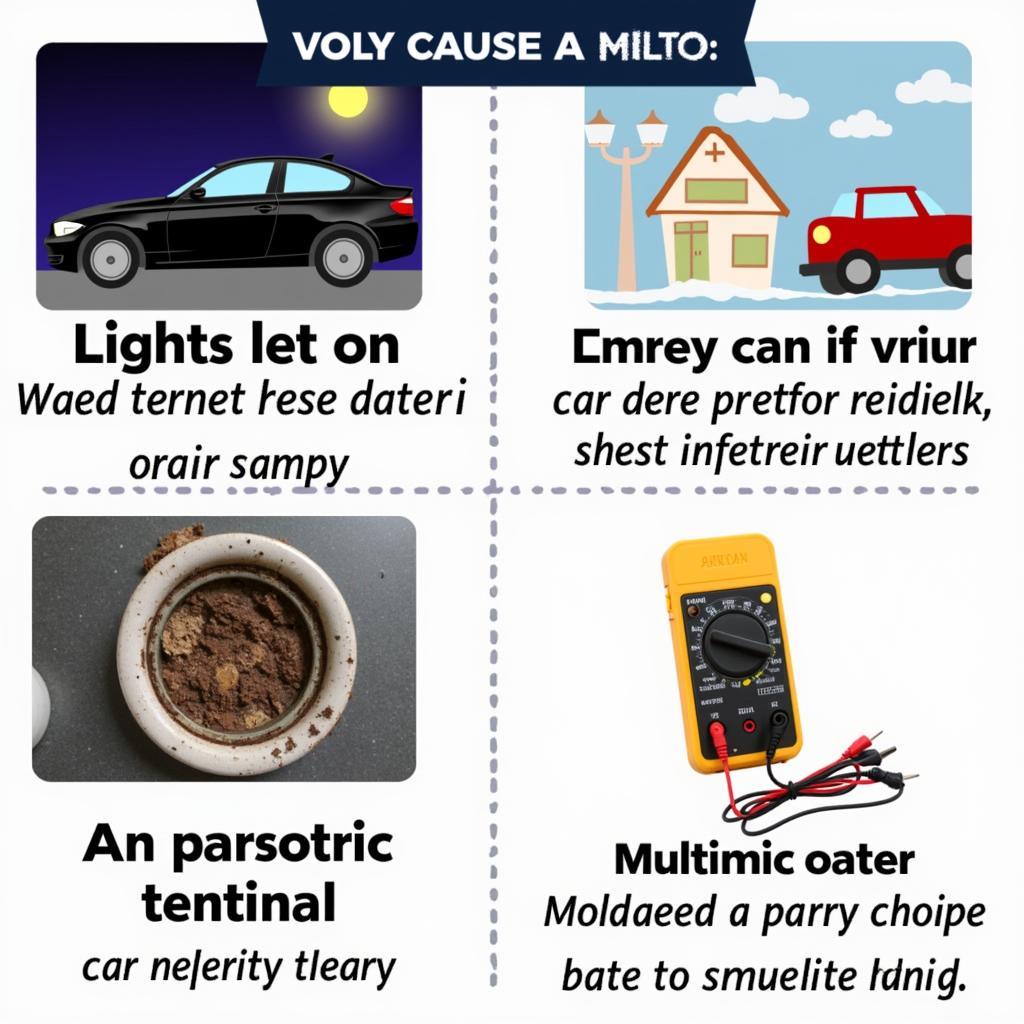A drained car battery can be a frustrating experience, leaving you stranded and needing a drained battery recharge. This comprehensive guide covers everything from diagnosing the cause to recharging and preventing future drain issues. Learn how to get your car back on the road quickly and efficiently. recharge drained car battery
Understanding Why Your Car Battery Drains
A car battery doesn’t just drain for no reason. Several factors contribute to a drained battery, ranging from simple user errors to more complex mechanical or electrical problems. Identifying the underlying cause is crucial for a successful drained battery recharge and preventing future occurrences.
Common Causes of a Drained Car Battery
- Leaving lights on: This is a classic culprit. Interior lights, headlights, or even trunk lights left on can quickly drain your battery.
- Extreme temperatures: Both hot and cold weather can affect battery performance. Extreme heat can evaporate battery fluid, while extreme cold can slow down chemical reactions.
- Old battery: Over time, car batteries lose their ability to hold a charge. If your battery is several years old, it might be time for a replacement.
- Parasitic drain: Even when your car is off, certain electrical components can continue to draw power, leading to a slow drain. This could be due to faulty wiring, a malfunctioning alternator, or even a glove compartment light that won’t turn off.
- Short trips: Short drives don’t give the alternator enough time to fully recharge the battery, especially if you’re using power-hungry accessories like the heater or air conditioning.
 Common Causes of Drained Car Batteries
Common Causes of Drained Car Batteries
How to Recharge a Drained Car Battery
Several methods exist for recharging a drained car battery, each with its pros and cons. Choosing the right method depends on your situation and available resources.
Using a Battery Charger
A battery charger is the most common and effective method for a drained battery recharge. Connect the positive (red) clamp to the positive terminal of the battery and the negative (black) clamp to a metal ground on the car chassis. Then, plug in the charger and follow the manufacturer’s instructions.
Jump Starting Your Car
Jump-starting involves using another vehicle’s battery to provide a temporary charge to your drained battery. Connect the jumper cables correctly, ensuring positive to positive and negative to negative. Start the working vehicle, let it run for a few minutes, then try starting your car. If it starts, let it run for at least 30 minutes to allow the alternator to recharge the battery. For more insights, explore how a car battery might die after not being driven: car battery died after not driving.
When Your Battery is Fully Drained
If your car battery is fully drained, jump-starting might not be enough. In such cases, a drained battery recharge using a dedicated charger is usually necessary. You can find more information about fully drained batteries here: car battery fully drained.
“A fully drained battery requires a slow and steady recharge to restore its full capacity,” says John Smith, Senior Automotive Electrical Engineer at AutoTech Solutions. “Using a trickle charger is often the best approach in these situations.”
Preventing Future Battery Drain
Once you’ve recharged your battery, take steps to prevent future drain issues. Regular maintenance and simple precautions can save you time, money, and frustration.
- Regularly check your battery terminals for corrosion: Clean them with a wire brush and baking soda solution if necessary.
- Have your battery tested periodically: A professional can determine its health and identify potential problems.
- Be mindful of electrical accessories: Turn off lights, radio, and other accessories when not in use.
- Limit short trips: If you must take short trips, consider combining errands to give the alternator enough time to recharge the battery. If your battery keeps draining, you’ll find helpful solutions here: my battery keeps draining.
“Preventive maintenance is key to extending the life of your car battery and avoiding unexpected drain issues,” advises Jane Doe, Lead Technician at Automotive Service Excellence. “Regular inspections and simple checks can go a long way.”
Conclusion
A drained battery recharge is a manageable process, and understanding the causes and solutions can empower you to handle such situations effectively. By following the steps outlined in this guide and adopting preventive measures, you can keep your car battery healthy and avoid the inconvenience of a dead battery. Don’t let a drained battery keep you from getting where you need to go! You might also encounter power steering issues after a dead battery. Learn more about it here: no power steering after dead battery.

